How to properly process raspberries in the spring from diseases and pests, what means to use
Raspberry belongs to unpretentious berry crops. Most varieties are frost-hardy and bear fruit stably in the southern and northern latitudes. To obtain a rich harvest, it is recommended to devote time and attention not only to watering and fertilizing, but also to treating the bush from diseases and pests.
In rainy and cloudy weather, pests appear on raspberries, and with a lack of mineral and organic substances, viral, bacterial and fungal diseases. To prevent their occurrence, with the arrival of spring, summer residents take a number of preventive measures.
How to treat raspberries in the spring from diseases and pests and what to pay special attention to, we will tell in the article.
The content of the article
Purposes of Spring Raspberry Processing
The main goal is to protect against diseases and insects. In spring, warm weather sets in, the soil and air warm up, microorganisms and insect larvae wake up, many of which are dangerous for raspberries. If you do not process the raspberry, soon fungal spores and harmful bacteria will appear on the bushes., which over time will provoke the development of diseases. The plant's immunity, its yield, and resistance to negative external factors depend on the treatment. Otherwise, the bush will get sick, it will give few berries.
What pests threaten raspberries
To protect raspberries from insect pests, it is recommended to study the description of the most common ones. These include the raspberry beetle, weevil and glass beetle.
Raspberry beetle
The size of the insect does not exceed 6 mm, the color is gray-brown. Raspberry beetle, or raspberry, multiplies quickly, its offspring is able to destroy the entire crop.
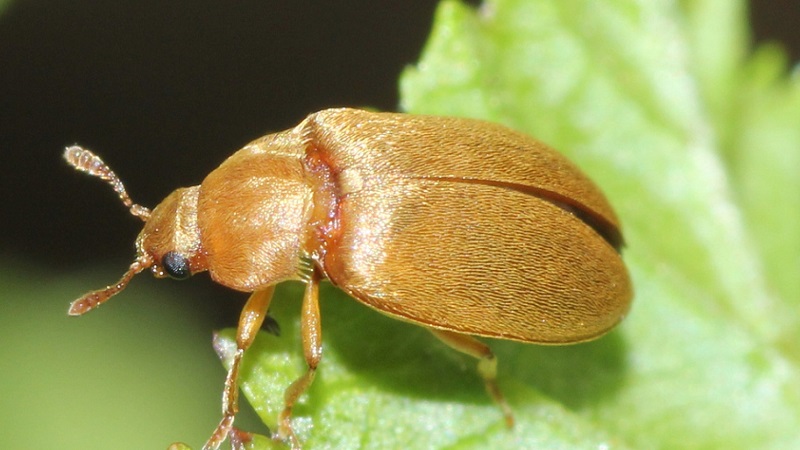
The pest appears in late April or early May, when the soil warms up to + 12 ° C... First, the raspberry beetle eats the leaves, after which it proceeds to the shoots and young fruits. If the beetle is not destroyed, at the end of summer it burrows into the ground and pupates to reappear the next year.
Important! Raspberry loves pears, plums, apples and can get on the bushes from these crops.
Raspberry glass
Caterpillars hibernate inside damaged shoots, then gnaw holes in the roots and stems... The body of the glass bowl is thin, the adult butterfly is painted in black and blue. In the caterpillar stage, the insect is white, the head is brown or orange.

If you do not find a raspberry glass in a timely manner, then the bushes dry out, the branches become weak and take on a painful appearance. If it was possible to see signs of damage, then weak shoots are removed and burned away from the garden area. The remaining bush is sprayed with systemic fungicides.
Weevils
It is easy to recognize the beetle by its gray-black color and elongated proboscis. Weevil it is activated in the spring, when the air temperature warms up to + 14 ° C.
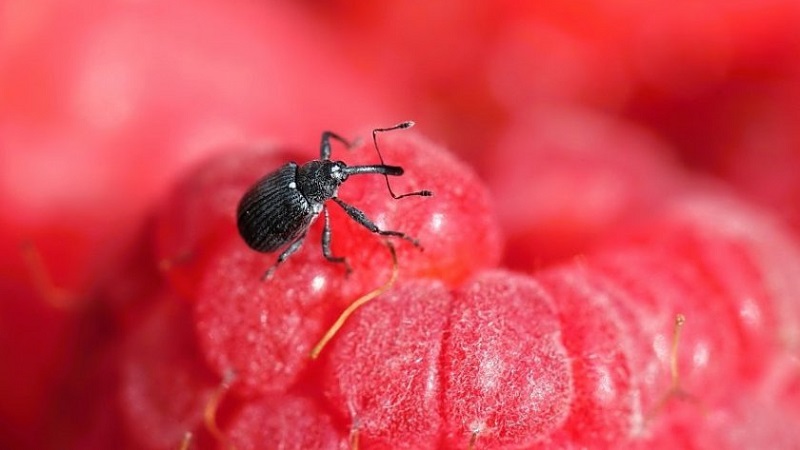
Insects lay eggs in flower buds, causing them to turn brown.... Because of this, the yield of raspberries is reduced by 40-70%. Weevils especially often appear in old areas where pruning and the formation of raspberry bushes have not been carried out for a long time.
Interesting on the site:
What diseases
The greatest danger to raspberries is represented by fungal diseases.... They develop quickly in hot and humid environments, and do not spare the harvest.
White spot, or septoria
Fungal disease activates in late spring or early summerwhen the weather is humid and hot. Fungal spores multiply quickly if plants planted close to each other. Septoria does not spare berry, flower, and fruit crops.
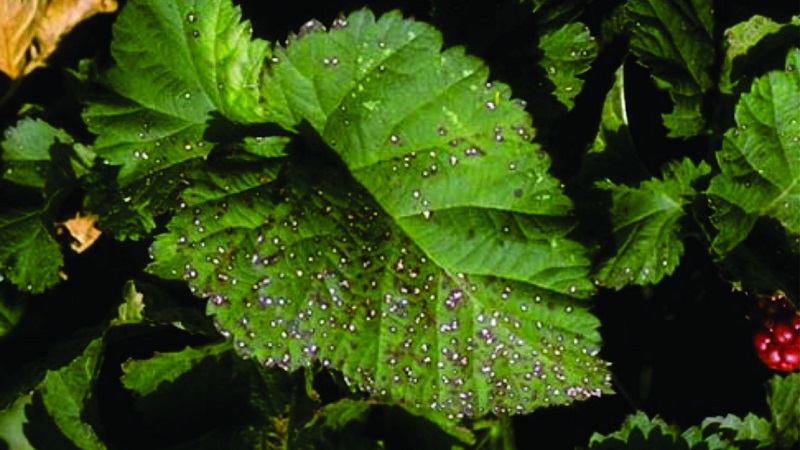
Signs of infection - white blurred spots and bloom on leaves, shoots, fruits. In case of severe damage, the raspberry buds die off, the bark on the shoots cracks. For the purpose of prevention, it is important to follow the rules of crop rotation, monitor the density of plantings, and pay attention to protective measures.
Anthracnose
The disease is caused by a harmful fungus... He is able to destroy the entire crop in a season. Fungal spores are carried by wind, insects, and rain. At first, signs of damage appear on the leaves, gradually moving to shoots and berries (green and red).
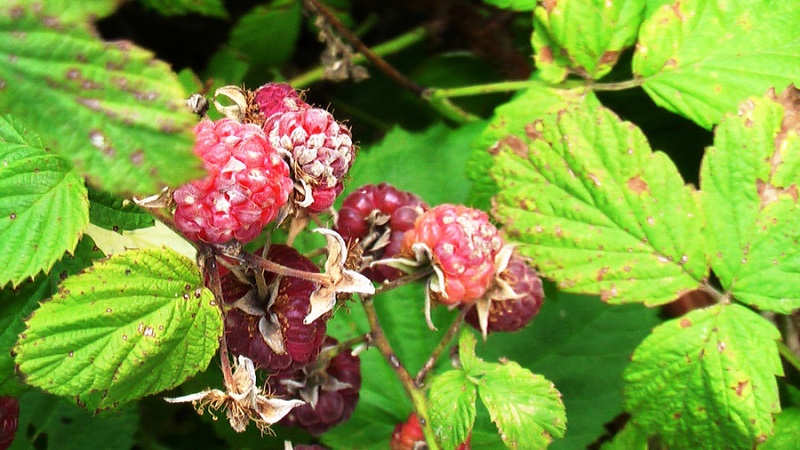
Raspberry bushes are covered with small gray-brown spots with a dark rim, young shoots - ulcers, the top of the bush dries up. Spores of the fungus are frost-resistant - if they are not destroyed, the disease attacks raspberries the next year.
Gray rot
The fruits are affected by gray rot - the berries are covered with brown spots, lose their elasticity, and deform. Gray-brown spots with fluff appear on the leaves. Gray rot overwinters on plant debristherefore it is important to remove and incinerate them in a timely manner.
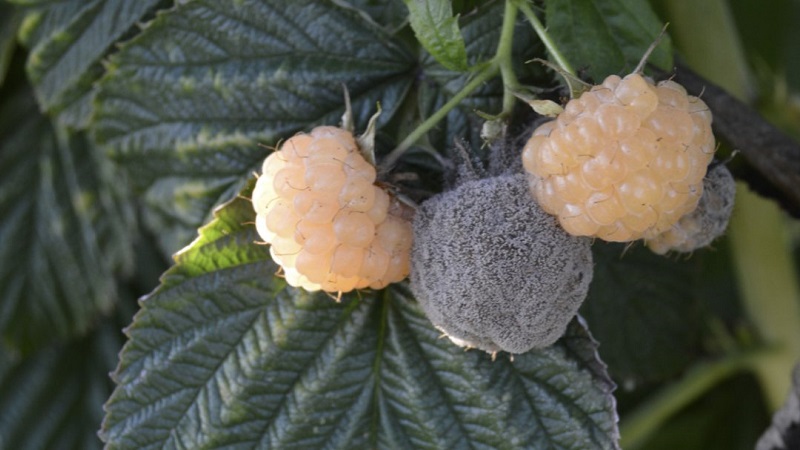
Disease spreads quickly in rainy weather, as well as in thickened and debris-polluted plantings... The affected areas are removed and burned, and the remaining plants are sprayed with protective and medicinal preparations.
Interesting. Gray rot affects not only raspberries in the garden, but also berries during storage. They become covered with gray fluff, lose their taste and marketability. Raspberries become watery and unusable. Gardeners discard or burn such fruits.
Processing time
The first time raspberries are processed before flowering, in early spring... In the southern regions it is approximately mid-March, in central Russia and the northern regions - the end of March or early April. At this time, summer residents use folk remedies (ash, soap, iodine) or simply spray the plants with boiling water.
The second time the raspberries are processed in 2-3 weeks - use spraying with Bordeaux liquid or copper sulfate. The procedure is carried out in dry and calm weather so that the rain does not wash away the preparations. The next processing is carried out only in summer, in early to mid-June.
Preparatory activities
As soon as the snow has melted from the ground, gardeners remove last year's foliage and other debris. There should be nothing under the raspberries except clean soil... The earth is loosened to disrupt the wintering grounds for raspberry flies, glass flies and other pests.
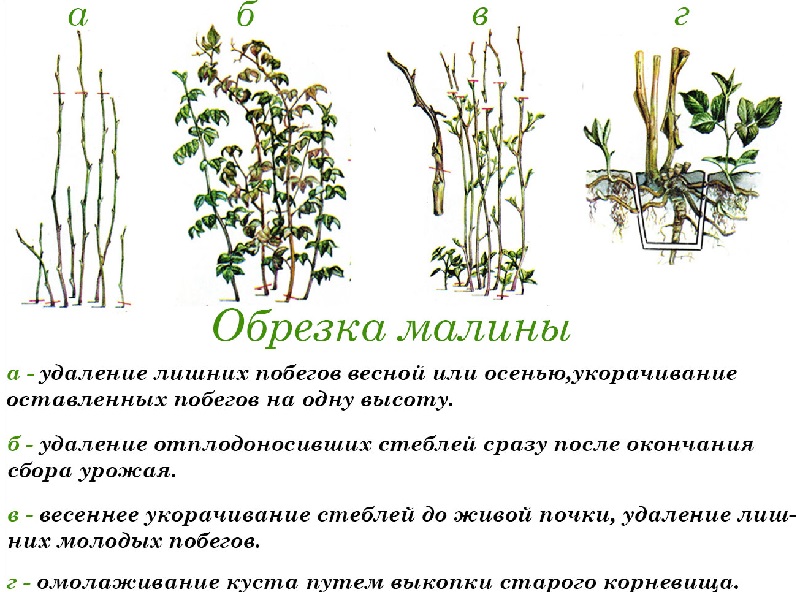
The main stage of preparing raspberries for processing is pruning a bush... The procedure increases the yield of raspberries and prevents the appearance of diseases and pests. Summer residents cut dry, broken and weak shoots, pinch the top and thin out the branches. If this is not done, then they will grow in a chaotic manner, which will negatively affect the number of berries harvested. In addition, pruning gives the bushes a neat appearance - the raspberry tree looks well-groomed and attractive.
Attention! Cut the raspberries until the buds open. In the south of the country it is March or early April, in the middle lane - late April or early May. It is easy to distinguish old shoots from new ones - they have many side and short branches, they break. The new shoots are covered with green buds and are firm and flexible. Summer residents inspect the bushes, cut off old shoots without swollen buds.
How to spray
For preventive purposes, gardeners use folk remedies, for medicinal purposes - chemical and biological.
Purchased chemicals
Chemicals effectively protect raspberries from diseases and pests - a wide range of drugs are sold in specialized shops for the garden and vegetable garden. "Nitrafen" helps to get rid of the raspberry beetle and glass case - 200 g of the drug is diluted in 10 liters of water. The pungent brown paste also helps heal anthracnose, gray mold, and lichen.
Process raspberries until bud breakso that the leaves do not get sunburn. In summer, the treatment with "Nitrafen" is not carried out, since it is dangerous for the environment and humans.
In the fight against spider mites, aphids and weevils use "Kemifos". For 10 liters of water, 10 mg of the drug is required. It gets rid of larvae and adults, has a long lasting effect. The bushes are sprayed before and after harvesting, the liquid consumption is up to 2 liters per 10 bushes. "Kemifos" quickly wears out, is used not only by amateur gardeners, but also by farmers.
Attention! A common and time-tested chemical agent for effective control of diseases and pests is Bordeaux liquid. During the period of swelling of the kidneys, a 3% solution is used. The product is evenly distributed over the leaves. It destroys fungal spores that have survived the winter. The liquid penetrates into small cracks in the bush, where dangerous microorganisms invisible to the human eye live.
Biological agents
Biologicals are less aggressive than chemical... To protect against insects and diseases, gardeners use BioKill, a safe and non-toxic product. It is used for spring and summer processing of raspberries, has a complex effect - destroys old diseases and prevents the appearance of new ones. The drug works already 2-3 hours after treatment. 1 bucket of water requires 1 ampoule. Spray raspberries in the morning or in the evening, the appropriate temperature for processing is from + 12 ° C to + 25 ° C. The finished solution cannot be stored, it must be used within 24 hours.
Biological preparation "Planriz" is used to protect against powdery mildew and anthracnose... It is used at any stage of plant development, including flowering. The product has a bactericidal effect, does not reduce the nutrient composition of the soil, it is safe for humans and animals. Also, "Planriz" is compatible with chemicals and folk remedies.
Aphids and caterpillars get rid of with the help of Fitoverm biological product... After 3-4 hours, pests stop feeding, and complete disposal of insects occurs in 2-3 days. Fitoverm does not accumulate in the plant, it is used in any kind of soil. To process one bush, you need 1 liter of water and 2 ml of the drug.
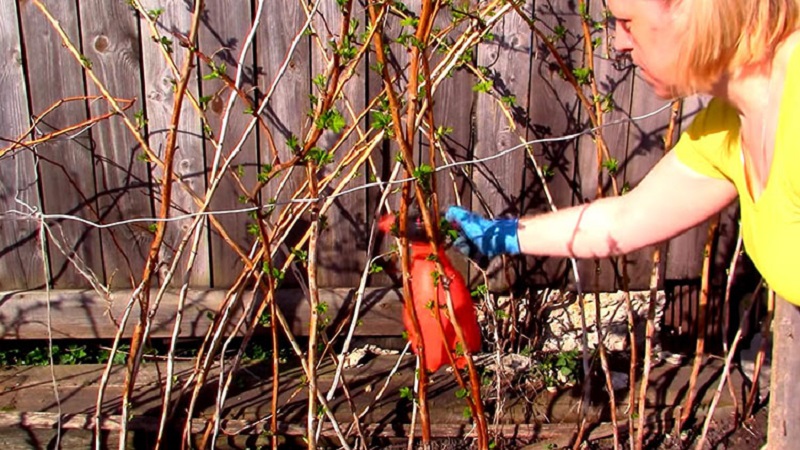
Folk remedies
Folk remedies have a preventive effect, in the spring they are used 2-3 times... A solution of ammonia is effective - for 10 liters of water, 30 ml of the finished substance is required. Raspberries are watered at the rate of 2 liters per bush. Summer residents also prepare an infusion of birch tar - 15 g of tar and 40 ml of liquid soap are required for 10 liters of water. Stir the mixture thoroughly and water the bushes under the root in the morning or evening. Consumption - 1.5-2 liters per bush.
Attention! Mustard is also used for processing. Add 20 g of mustard powder to 10 liters of water and leave in a dark place for 4-5 hours. The solution protects raspberries from weevils, caterpillars, raspberries and spider mites.
How to properly carry out spring processing of raspberries
For processing to be not only effective, but also safe, it is important to observe advice from experienced gardeners and precautions:
- For the preparation of chemical and biological preparations, do not use food utensils - use special garden tools or disposable containers.
- Prepare personal protective equipment - goggles, respirator, gloves, protective suit or apron.
- Study the dosage and recommendations for preparing the solution, do not store the finished mixture at home, observe the temperature regime of processing.
- Spray not only the bushes, but also the ground and the mulch between them. For preventive purposes, treat plants growing near the raspberry tree.
- Do not spray plants with children, pets, pregnant or lactating women nearby.
- Do not mix several biological and chemical products with each other, unless the manufacturer recommends it.
Are there any nuances in the processing of remontant raspberries
Repaired raspberries constantly need mulch - it retains moisture in the soil and protects against weeds. Therefore, during spring processing, it is recommended to remove last year's layer and add a new one. Also, during spring pruning, gardeners remove all branches without leaving stumps. This allows you to get more large fruits.
Repaired varieties less frequently affected by diseases and pests... However, this does not mean that they do not need preventive measures. With the arrival of spring, it is important to spray the raspberries with a solution of Bordeaux liquid or copper sulfate.
Further spring care and feeding
After trimming raspberries tied to a support, especially if large-fruited varieties are grown. A trellis is installed between two bushes, to which the stems are tied on both sides. With this method, raspberries do not shade each other, the berries ripen at the same time.
Organic fertilizers are used for spring feeding - 0.5 kg of cow dung is diluted in 10 liters of water. For 1 sq. m plantings consume about 1.5 liters. Ammonium nitrate, superphosphate, potassium salt are added to the second dressing in the spring. Before each top dressing, the soil is loosened and mulched using cut grass, sawdust, needles, ash, crushed stone.
Can not imagine plant care without watering. Raspberries are moisture-loving, at the same time, they do not tolerate waterlogging... The number and frequency of watering depends on the weather conditions and the condition of the raspberry tree. The soil should be saturated with water by 10-15 cm. The approximate water consumption is up to 2 liters per one bush 3-4 times per month. If the summer is rainy, then the amount of watering is reduced. It is important not to forget about removing weeds - excess vegetation stimulates the development of diseases and takes away nutrients from raspberries.
Conclusion
For spraying raspberries from folk remedies, summer residents choose ammonia, ash, laundry or liquid soap; from chemicals and biological products - "Fitoferm", Bordeaux liquid, urea, copper sulphate, "Planriz". When preparing the solution, it is recommended to observe dosages and safety rules. Treat raspberries in the morning or evening to avoid sunburn. The first treatment is carried out in late March or early April, before the procedure, the shrub is necessarily cut off.